Evolutionary Characteristics, Improvement Strategies and Driving Mechanisms of the Human Settlement Environment in Chinese Traditional Villages Based on Historical Hydrological Resilience Assessment
Abstract
1. Introduction
1.1. Background
1.2. Literature Review
1.2.1. Theoretical and Practical Development of Human Settlements Resilience Assessment
1.2.2. The Absence of a Perspective on the Historical Hydrological Dimension and the Entry Point of This Paper
- (1)
- Assessment separation: Most human settlements’ resilience assessments fail to deeply integrate historical hydrological systems as a key dimension, resulting in the weakening of the active role of “water”.
- (2)
- Weak evolutionary analysis: Research on village hydrological systems lacks a long-term perspective to quantitatively analyze their evolution process and characteristics from “adapting to nature” to “transforming nature” and then to “system degradation”.
- (3)
- Ambiguous path of wisdom translation: There is a lack of systematic methodological exploration of how traditional water management wisdom (such as pond systems, community water management mechanisms) can be transformed into modern and usable improvement strategies.
1.2.3. Driving Mechanism Research: From a Single Subject to Multi-Party Synergy
1.2.4. Research Orientation and Core Issues of This Paper
- (1)
- Construct a human settlements resilience assessment framework that integrates historical hydrological dimensions for precise assessment;
- (2)
- Through the analysis of long-term time series data, reveal the dynamic evolution characteristics of the human settlement environment under the influence of the hydrological system;
- (3)
- Propose a systematic improvement strategy that integrates “traditional–modern” and construct an operational multi-drive mechanism.
- (1)
- How to quantitatively assess the level of historical hydrological resilience of traditional Chinese villages and characterize their spatiotemporal evolution.
- (2)
- Based on the above assessment and evolution patterns, how to construct effective resilience enhancement strategies and multi-driver mechanisms.
1.3. Research Objectives and Purposes
- (1)
- Evaluation framework construction: Define the connotation of “historical hydrological resilience” and establish a comprehensive evaluation index system that includes three dimensions: ecological governance, cultural inheritance, and social adaptation.
- (2)
- Analysis of evolutionary characteristics: Taking Baoyan Village as a case, quantitatively assess its historical and current hydrological resilience, and reveal its spatio-temporal evolution patterns and key obstacle factors.
- (3)
- Enhancement strategies and driving mechanism design: Propose a synergistic resilience enhancement path of “ecological–culture–society” and construct a four-element driving mechanism consisting of government guidance, community participation, technology empowerment, and industrial synergy.
1.4. Theoretical Innovation
1.4.1. Theoretical Innovation: Propose the Conceptual Framework of “Historical Hydrological Resilience”
1.4.2. Methodological Innovation: Building Evaluation Models for Multi-Source Data Fusion
1.4.3. Practical Innovation: Proposing a “Traditional–Modern” Integrated Resilience Enhancement Paradigm
1.5. Research Framework
2. Materials and Methods
2.1. Study Area
2.2. Data Sources
- (1)
- Historical document data: Collecting and organizing historical documents such as local Chronicles, water conservancy Chronicles, genealogies, and inscriptions, with a focus on extracting information such as historical hydrological events, water conservancy project construction, and social organization forms;
- (2)
- Spatial geographic data: including historical maps (1950s), modern remote sensing images (2020–2024), DEM data, land use data, etc., for spatial analysis and evolution studies;
- (3)
- Socio-economic data: Obtain data on population, economy, industry, etc., through statistical yearbooks, village Chronicles, etc.
- (4)
- Field research data: Primary information on community perception, traditional knowledge, adaptive behavior, etc. was obtained through participatory observation, semi-structured interviews (n = 35), questionnaires (n = 235), etc.
2.3. Research Methods
2.3.1. Construction of an Index System for a Historical Hydrological Resilience Assessment
2.3.2. Spatial Analysis and Mathematical Models
3. Case Study: Historical Hydrological Resilience in Baoyan Village
3.1. Formation and Evolution of Historical Hydrological Resilience
3.2. Resilience Assessment
3.2.1. Historical Hydrological Resilience Assessment
3.2.2. Resilience Assessment Results
4. Discussion
4.1. Modern Translation and Technological Innovation of Traditional Water Management Wisdom
4.1.1. Adaptive Engineering Restoration and Intelligent Empowerment
4.1.2. Adaptive Reuse of Hydraulic Heritage and Immersive Education
4.2. Construction of Resilient Networks for Ecological–Cultural Synergy
4.2.1. Shengli River Ecological Buffer Zone: Nature-Based Solutions (NbS)
4.2.2. Terraced Landscape Belt: A Fusion of Production, Ecology and Experience
4.3. Innovation in Multi-Party Governance and Long-Term Operation Mechanism
4.3.1. Community Capacity Building and Endogenous Driving Force Cultivation
4.3.2. Market-Based Risk Sharing and Sustainable Financing
4.3.3. Digital Governance Platform and Smart Decision-Making
4.4. The Dynamic Nature of Cultural Resilience: A Social Anthropological Perspective
4.5. Comparisons and Insights from an International Perspective
5. Conclusions
5.1. Core Findings of the Case Study
- (1)
- Resilience assessment and spatio-temporal differentiation characteristics: The comprehensive index of historical hydrological resilience (HHRI) of Baoyan Village is 0.67, showing an overall downward trend compared to the historical benchmark. The spatial pattern shows a significant differentiation of “core vulnerability–marginal resilience”, with high-risk areas (12.7%) highly concentrated in the historic town area along the old Tongji River, which is also a densely populated area of cultural heritage, revealing the common challenges faced by flood safety and cultural protection.
- (2)
- Multi-dimensional resilience evolution and imbalance: There are obvious dimensional differences in the decline of resilience. Among them, ecological governance resilience (0.48) and cultural heritage resilience (0.46) declined most severely, while social adaptation resilience (1.05) increased due to the improvement of modern water conservancy facilities and community organization. This indicates that Baoyan Village is facing a complex situation where “ecological–cultural” resilience is waning and “social–engineering” resilience is increasing.
- (3)
- Identification of key obstacle factors: The diagnosis of the obstacle degree model indicates that the integrity of the weir field (X4), the transmission of traditional disaster knowledge (X12), and the stability of the natural river channel (X3) are the three core obstacle factors restricting the improvement of hydrological resilience in Baoyan Village.
- (4)
- Feasibility verification of resilience enhancement pathways: Based on the above diagnoses, this study proposed and preliminarily verified the synergistic enhancement pathways of “ecological space reconstruction–activation of traditional water management wisdom–empowerment of cultural resilience” applicable to Baoyan Village. The case application shows that specific measures such as restoring the weir and field system, building sponge villages, transforming abandoned sluice gates into hydrological exhibition halls, and establishing the “water lane manager” system can be targeted to address the identified key obstacles and achieve the dual goals of flood safety and cultural inheritance.
5.2. Practical Implications and Policy Recommendations
5.3. Research Limitations and Prospects
5.3.1. Research Limitations
5.3.2. Prospects
Author Contributions
Funding
Data Availability Statement
Conflicts of Interest
References
- Holling, C.S. Resilience and stability of ecological systems. Annu. Rev. Ecol. Syst. 1973, 4, 460–482. [Google Scholar] [CrossRef]
- Meerow, S.; Newell, J.P.; Stults, M. Defining urban resilience: A review. Landsc. Urban Plan. 2016, 147, 38–49. [Google Scholar] [CrossRef]
- Folke, C.; Carpenter, S.R.; Walker, B.; Scheffer, M.; Chapin, T.; Rockström, J. Resilience thinking: Integrating resilience, adaptability and transformability. Ecol. Soc. 2010, 15, 20. [Google Scholar] [CrossRef]
- Harbiankova, A.; Scherbina, E.; Budzevich, M. Exploring the Significance of Heritage Preservation in Enhancing the Settlement System Resilience. Sustainability 2023, 15, 15251. [Google Scholar] [CrossRef]
- Cox, R.S.; Hamlen, M. Community Disaster Resilience and the Rural Resilience Index. Am. Behav. Sci. 2015, 59, 220–237. [Google Scholar] [CrossRef]
- Jiang, G.; Zhu, T. Rural China toughness evaluation index system construction and empirical. J. Stat. Decis. 2024, 40, 75–80. [Google Scholar] [CrossRef]
- Zhu, T.; Jiang, G.; Cao, J. Evaluation of Resilience of Rural Human Settlements in China and analysis of Obstructive factors. Ecol. Econ. 2024, 40, 89–96. [Google Scholar]
- Zhou, M.; Liu, Q.; Wang, Y.; Lv, S. Research on Resilience Evaluation and Enhancement Strategies of Traditional Villages from the Perspective of Governance Networks: A Case Study of Wuzhong District, Suzhou City. South. Archit. 2025, 3, 74–84. Available online: https://link.cnki.net/urlid/44.1263.TU.20250402.1632.016 (accessed on 29 September 2025).
- Chen, Z. Effective Connection between Poverty Alleviation and Rural Revitalization from the Perspective of Evolutionary Resilience: An Investigation Based on Village G, Hunan Province. J. Northeast. Univ. (Soc. Sci. Ed.) 2024, 26, 90–99. [Google Scholar] [CrossRef]
- Liu, R.; Zhang, L.; Tang, Y.; Jiang, Y. Understanding and evaluating the resilience of rural human settlements with a social-ecological system framework: The case of Chongqing Municipality, China. Land Use Policy 2024, 136, 106966. [Google Scholar] [CrossRef]
- Yang, Z.; Sono, D. Promoting urban agriculture towards SDGs: An approach of combined assemblage and social-ecological system theories. Habitat Int. 2025, 163, 103479. [Google Scholar] [CrossRef]
- Tang, L.; Huang, Y.; Jiang, Y.; Feng, D. The Spatial Association of Rural Human Settlement System Resilience with Land Use in Hunan Province, China, 2000–2020. Land 2023, 12, 1524. [Google Scholar] [CrossRef]
- Tao, T.; Ma Li Liu, Y.; Tang, H.; Wang, X.; Wu, S. A systematic framework for rural resilience assessment in the rural Gansu Province, China. Environ. Impact Assess. Rev. 2025, 110, 107715. [Google Scholar] [CrossRef]
- Kim, G.; Kang, W.; Lee, J. Knowledge Structures and Components of Rural Resilience in the 2010s: Conceptual Development and Implications. Sustainability 2020, 12, 9769. [Google Scholar] [CrossRef]
- Gansauer, G.; Haggerty, J.; Dunn, J. Public Water System Governance in Rural Montana, USA: A ‘Slow drip’ on Community Resilience. Soc. Nat. Resour. 2023, 36, 1257–1276. [Google Scholar] [CrossRef]
- Beunen, R.; Patterson, J.; Assche, K. Governing for resilience: The role of institutional work. Curr. Opin. Environ. Sustain. 2017, 28, 10–16. [Google Scholar] [CrossRef]
- Son, J.; Pandey, R.; Dong, G.; Sharifi, A. Urban-Rural Disparity in Community Resilience: A Multilevel Analysis of the Relief Progress after the 2015 Nepal Earthquake. Sustain. Cities Soc. 2022, 79, 103698. [Google Scholar] [CrossRef]
- Roberts, E.; Townsend, L. The Contribution of the Creative Economy to the Resilience of Rural Communities: Exploring Cultural and Digital Capital. Soc. Rural. 2016, 56, 197–219. [Google Scholar] [CrossRef]
- Zhang, S.; Li, L.; Sun, H.; Xiao, T.; Dong, D. Spatio-temporal evolution of rural resilience in Anhui section of the Yangtze River Basin based on PSR model and its influencing factors. Acta Ecol. Sin. 2025, 45, 6231–6245. [Google Scholar] [CrossRef]
- Zhou, M.; Wang, Y.; Li, G. From Autonomy to Co-governance: The Spatial Governance Logic of Suzhou’s Traditional Villages from an Institutional Change Perspective. Hum. Geogr. 2024, 39, 72–82. Available online: https://link.cnki.net/doi/10.13959/j.issn.1003-2398.2024.05.009 (accessed on 29 September 2025).
- Li, S.; Dong, W.; Su, W.; Liu, D.; Chen, Y. Chongqing county rural urbanization system resilience space-time structure. J. Econ. Geogr. 2025, 45, 67–76. [Google Scholar] [CrossRef]
- Roth, D.; Winnubst, M. Moving out or living on a mound? Youdaoplaceholder0 planning a Dutch flood adaptation project. Land Use Policy 2014, 41, 233–245. [Google Scholar] [CrossRef]
- Henocque, Y. Enhancing social capital for sustainable coastal development: Is satoumi the answer? Coast. Shelf Sci. 2013, 116, 66–73. [Google Scholar] [CrossRef]
- Magni, F.; Lucertini, G.; Federico, K. From the lagoon-city to the lagoon of adaptive cities: Methodological approach to support trans-municipal and multilevel governance for climate adaptation in the Venice Lagoon. TeMA-J. Land Use Mobil. Environ. 2024, 1, 155–168. [Google Scholar] [CrossRef]
- Wu, Q.; Hu, J.; Xue, W. Measuring Rural Resilience and Development Pathways in Eastern Coastal Regions: A Case Study of Zhejiang Province. J. Zhejiang Univ. (Sci. Ed.) 2024, 51, 664–676. Available online: https://link.cnki.net/urlid/33.1246.N.20240906.1113.004 (accessed on 29 September 2025).
- Yang, M.; Jiao, M.; Zhang, J. Spatio-Temporal Analysis and Influencing Factors of Rural Resilience from the Perspective of Sustainable Rural Development. Int. J. Environ. Res. Public Health 2022, 19, 12294. [Google Scholar] [CrossRef]
- Wang, C.; Yan, X. Toughness of space and time differentiation in rural China and obstacle factor diagnosis. J. Econ. Issues 2022, 10, 91–97. [Google Scholar] [CrossRef]
- Li, Y.; Huang, H.; Song, C. Southwest China rural poor areas resilience research-in chongqing, for example. J. Hum. Geogr. 2022, 37, 97–105. [Google Scholar] [CrossRef]
- Wu, Y.; Liu, M.; Tian, B.; Tian, R.; Hu, Y. Evaluation of Disaster Resilience in Mountainous Rural Communities: A Case Study of Typical Representative Villages in the Anning River Basin of Liangshan Prefecture. Trop. Geogr. 2025, 45, 704–718. [Google Scholar] [CrossRef]
- Yang, Y.; Wang, Y. Exploring Rural Resilient Factors Based on Spatial Resilience Theory: A Case Study of Southern Jiangsu. Land 2023, 12, 1677. [Google Scholar] [CrossRef]
- Gacu, J.G.; Monjardin, C.E.F.; de Jesus, K.L.M.; Senoro, D.B. GIS-Based Risk Assessment of Structure Attributes in Flood Zones of Odiongan, Romblon, Philippines. Buildings 2023, 13, 506. [Google Scholar] [CrossRef]
- Hadipour, V.; Vafaie, F.; Deilami, K. Coastal Flooding Risk Assessment Using a GIS-Based Spatial Multi-Criteria Decision Analysis Approach. Water 2020, 12, 2379. [Google Scholar] [CrossRef]
- Cao, F.; Xu, X.; Zhang, C.; Kong, W. Evaluation of urban flood resilience and its Space-Time Evolution: A case study of Zhejiang Province, China. Ecol. Indic. 2023, 154, 110643. [Google Scholar] [CrossRef]
- Cumming, G.S. Spatial resilience: Integrating landscape ecology, resilience, and sustainability. Landsc. Ecol. 2011, 26, 899–909. [Google Scholar] [CrossRef]
- Wang, Z.; Zhu, J.; Wu, Z. Study on the spatial distribution characteristics of traditional villages and their response to the water network system in the lower yangtze river basin. Sci. Rep. (Nat. Publ. Group) 2024, 14, 22586. [Google Scholar] [CrossRef]
- Feng, Y.; Wei, H.; Huang, Y.; Li, J.; Mu, Z.; Kong, D. Spatiotemporal evolution characteristics and influencing factors of traditional villages: The Yellow River Basin in Henan Province, China. Herit. Sci. 2023, 11, 97. [Google Scholar] [CrossRef]
- Wang, H.; Shan, Y.; Xia, S.; Cao, J. Traditional Village Morphological Characteristics and Driving Mechanism from a Rural Sustainability Perspective: Evidence from Jiangsu Province. Buildings 2024, 14, 1302. [Google Scholar] [CrossRef]
- People’s Government of Baoyan Town. Baoyan Historical and Cultural Town Protection Plan; People’s Government of Baoyan Town: Zhenjiang, China, 2017.
- Wang, Y.; Wu, C.; Wu, B.; Zhao, J.; Wang, H. Evaluation of Spatial Structure Resilience in Coastal Traditional Villages Using Complex Network Analysis: A Case Study of Rongcheng City, Shandong Province. Land 2025, 14, 505. [Google Scholar] [CrossRef]
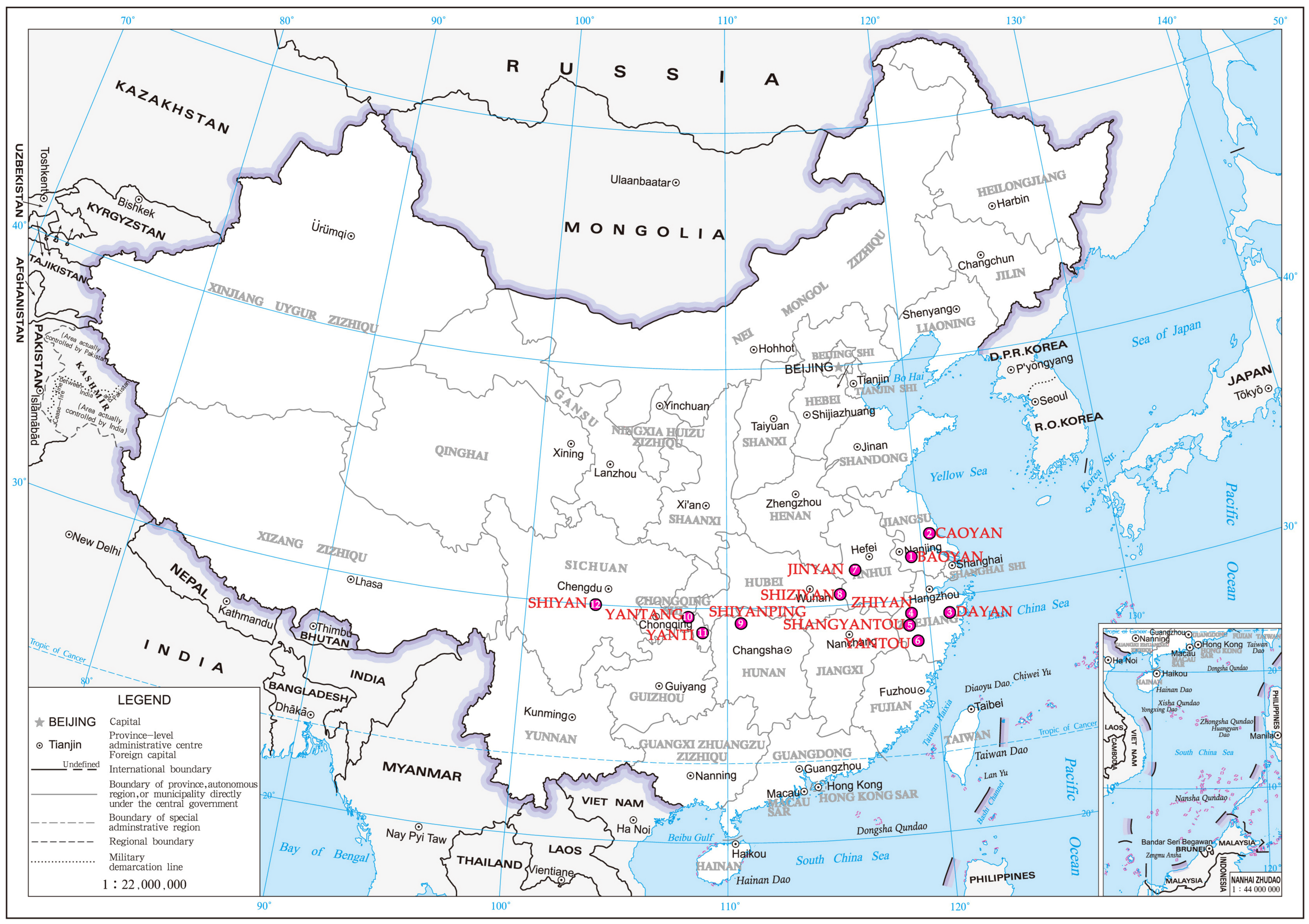
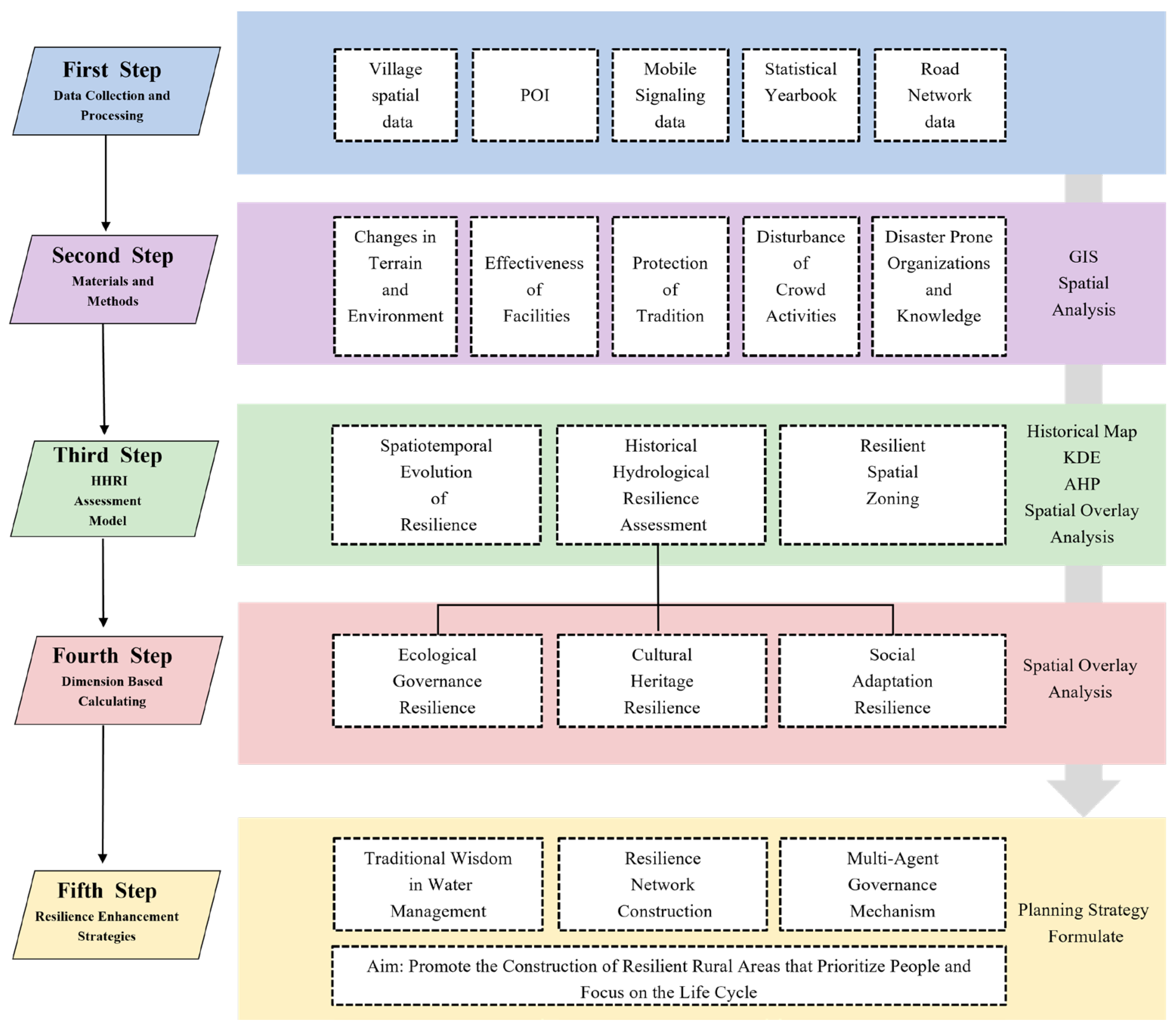

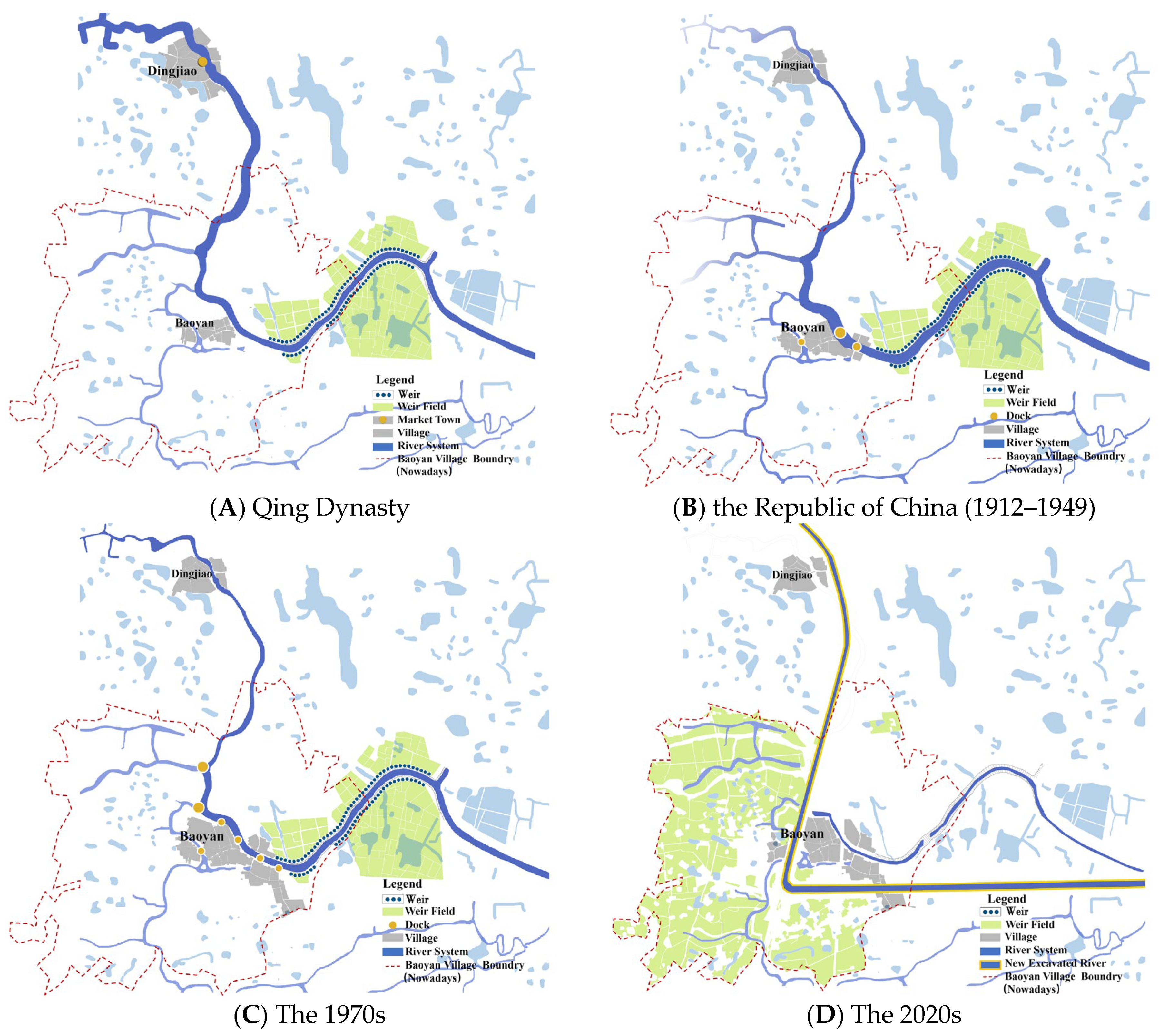
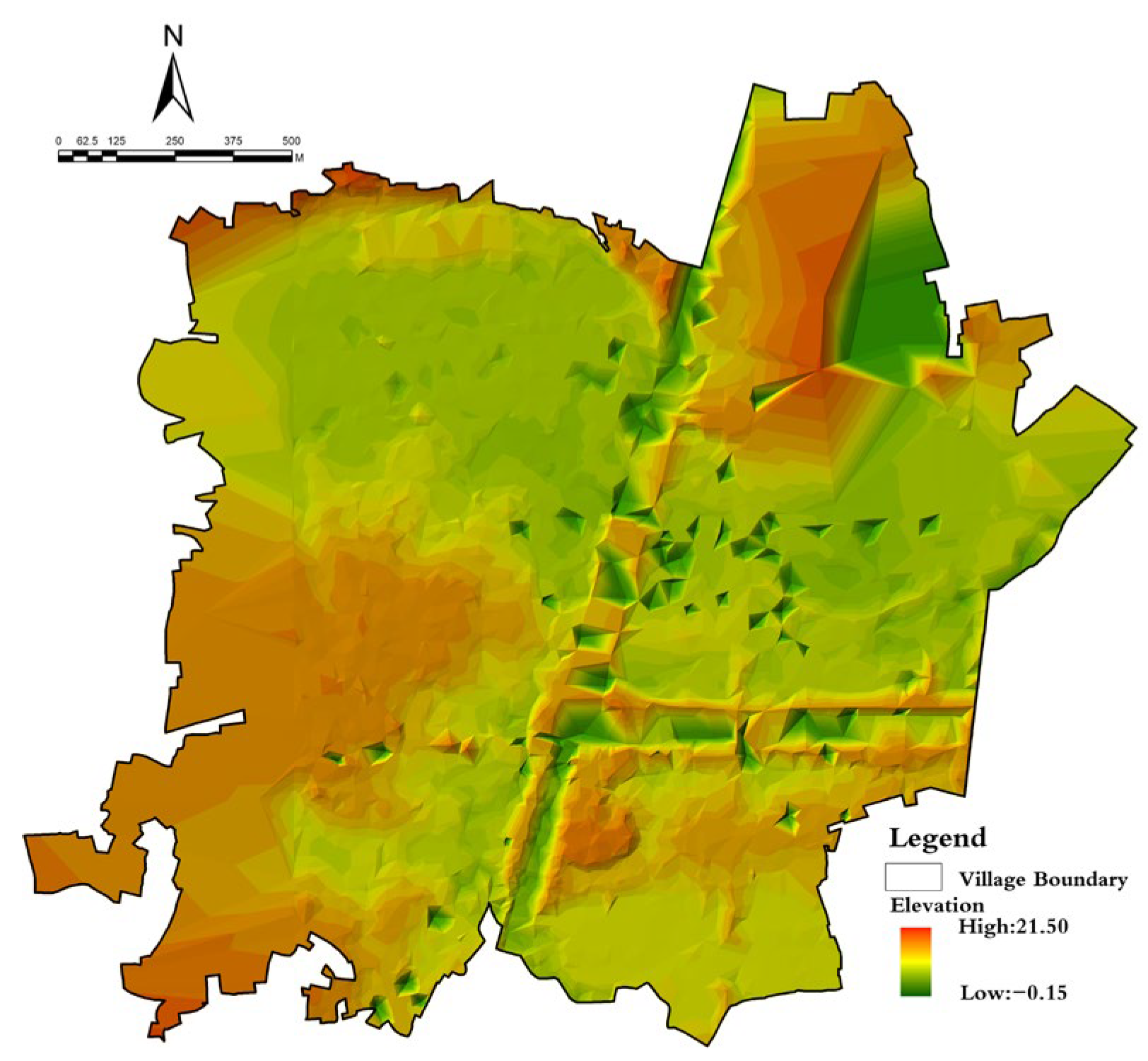
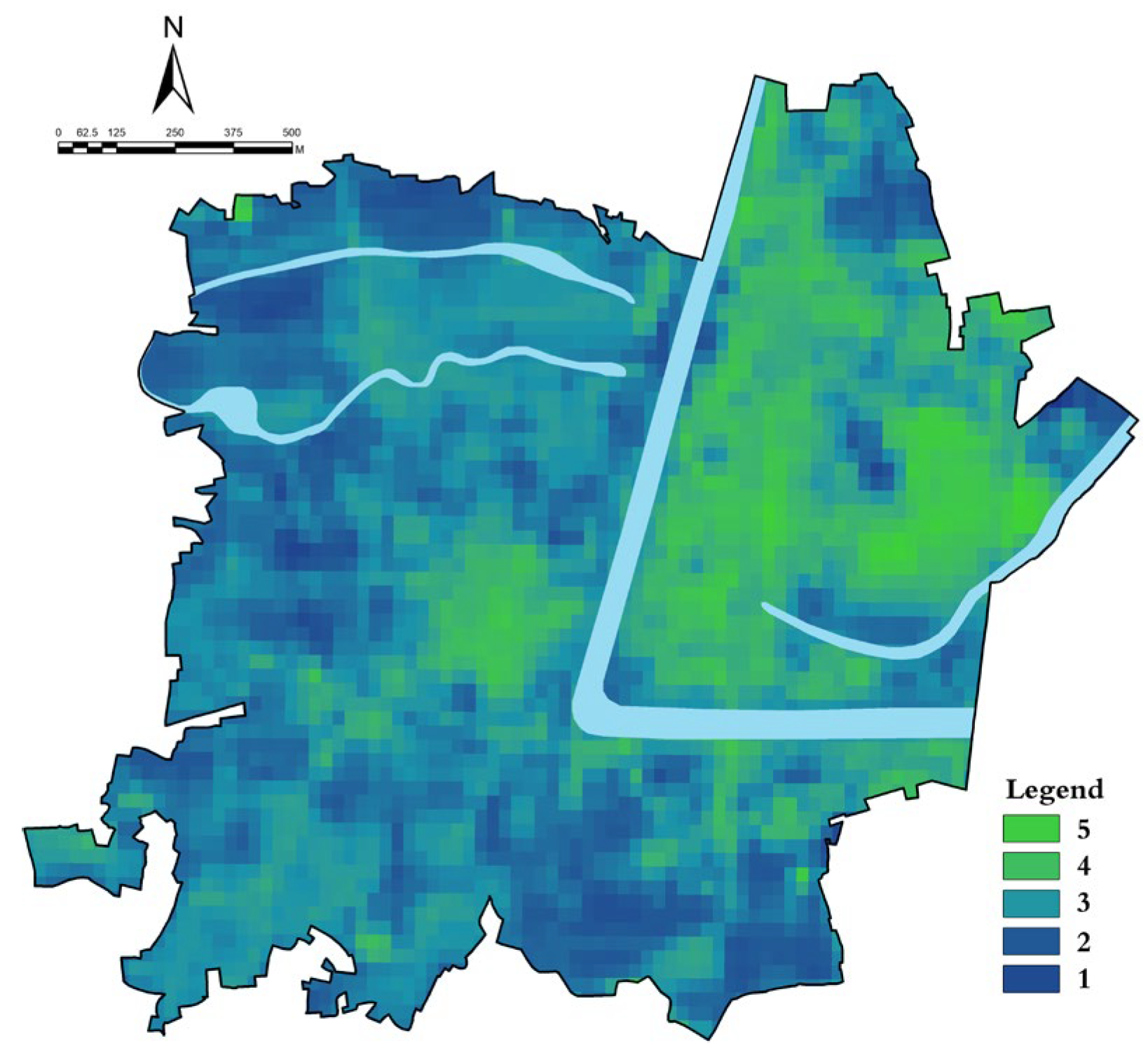
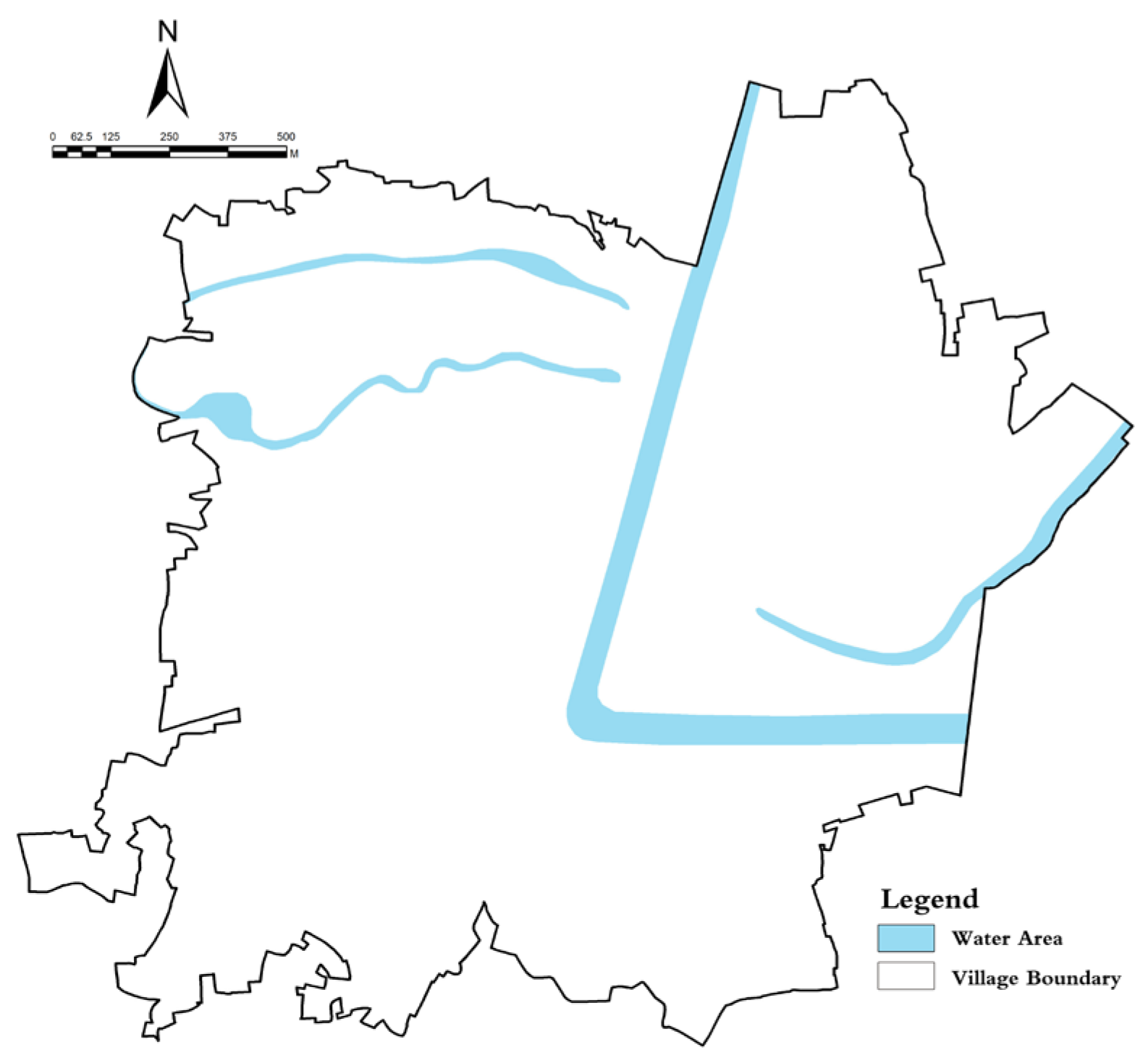
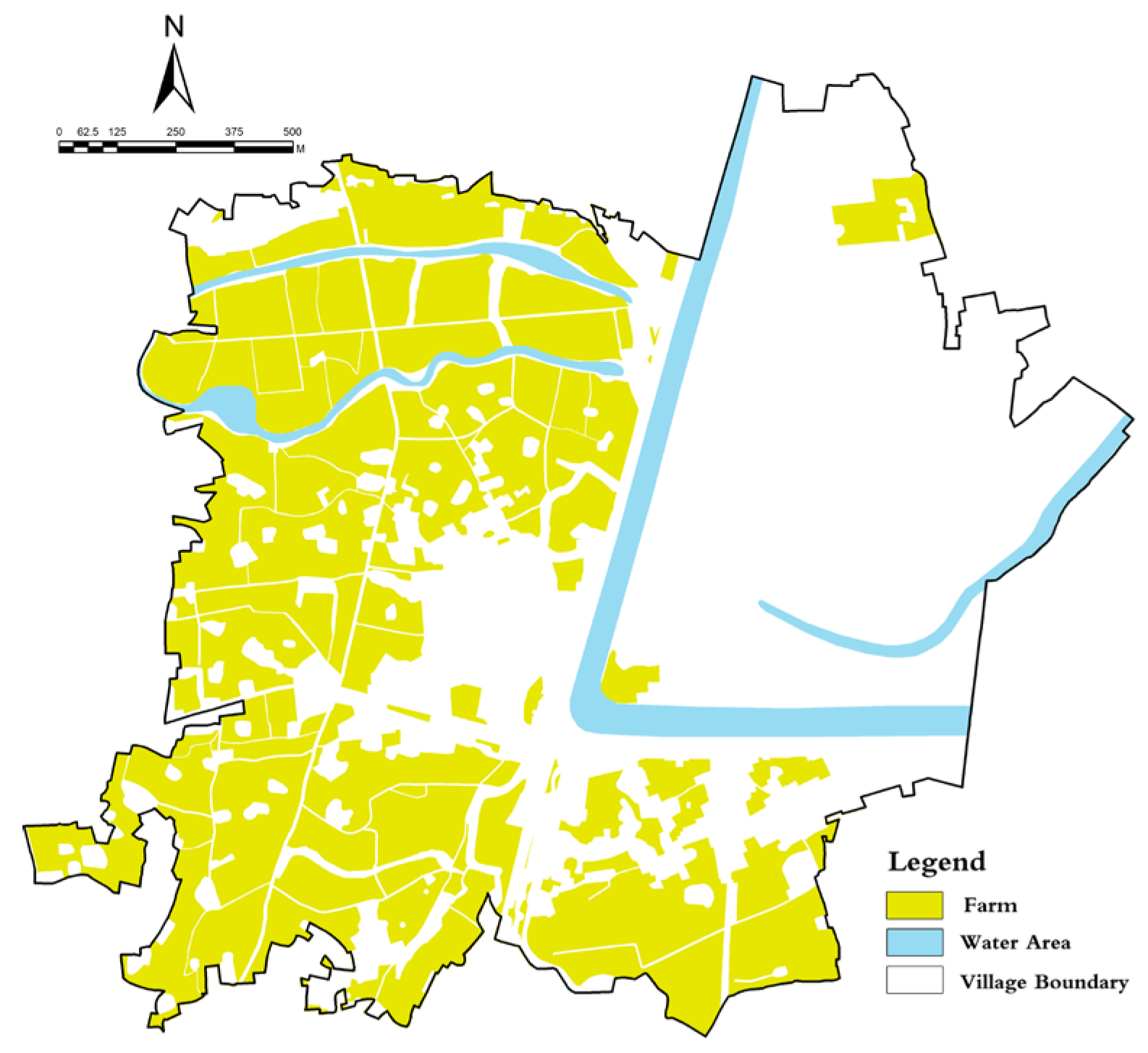
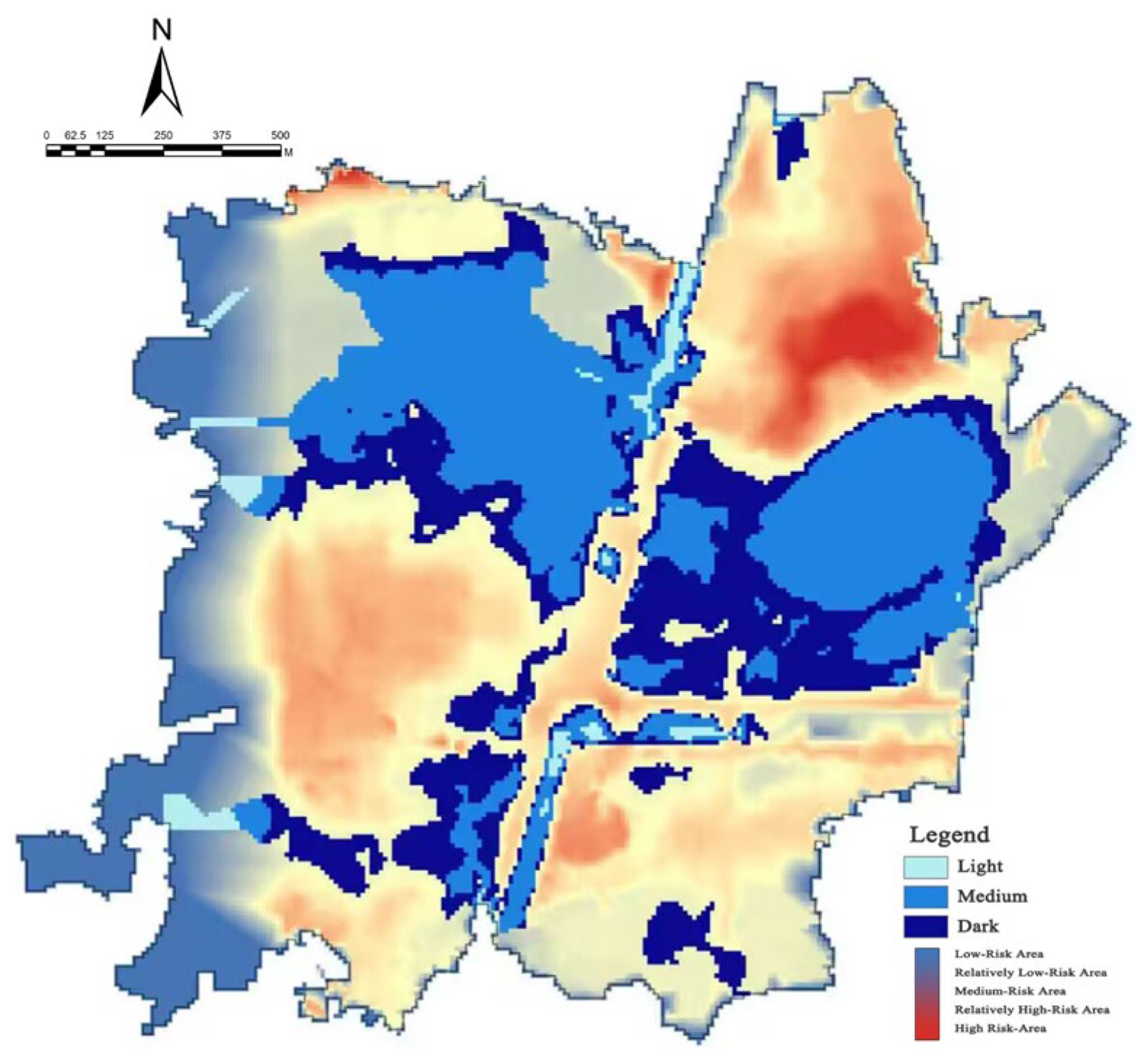

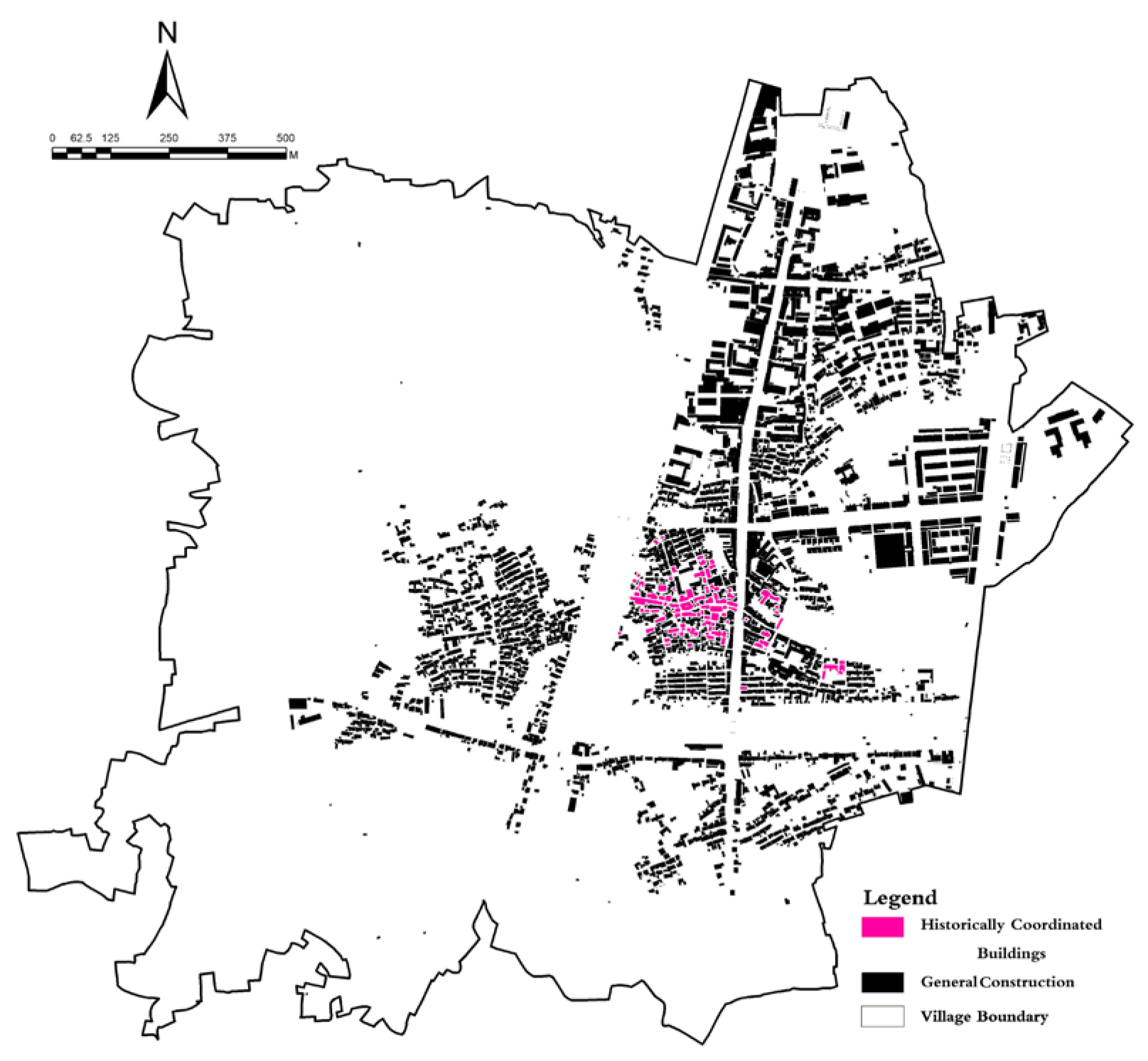


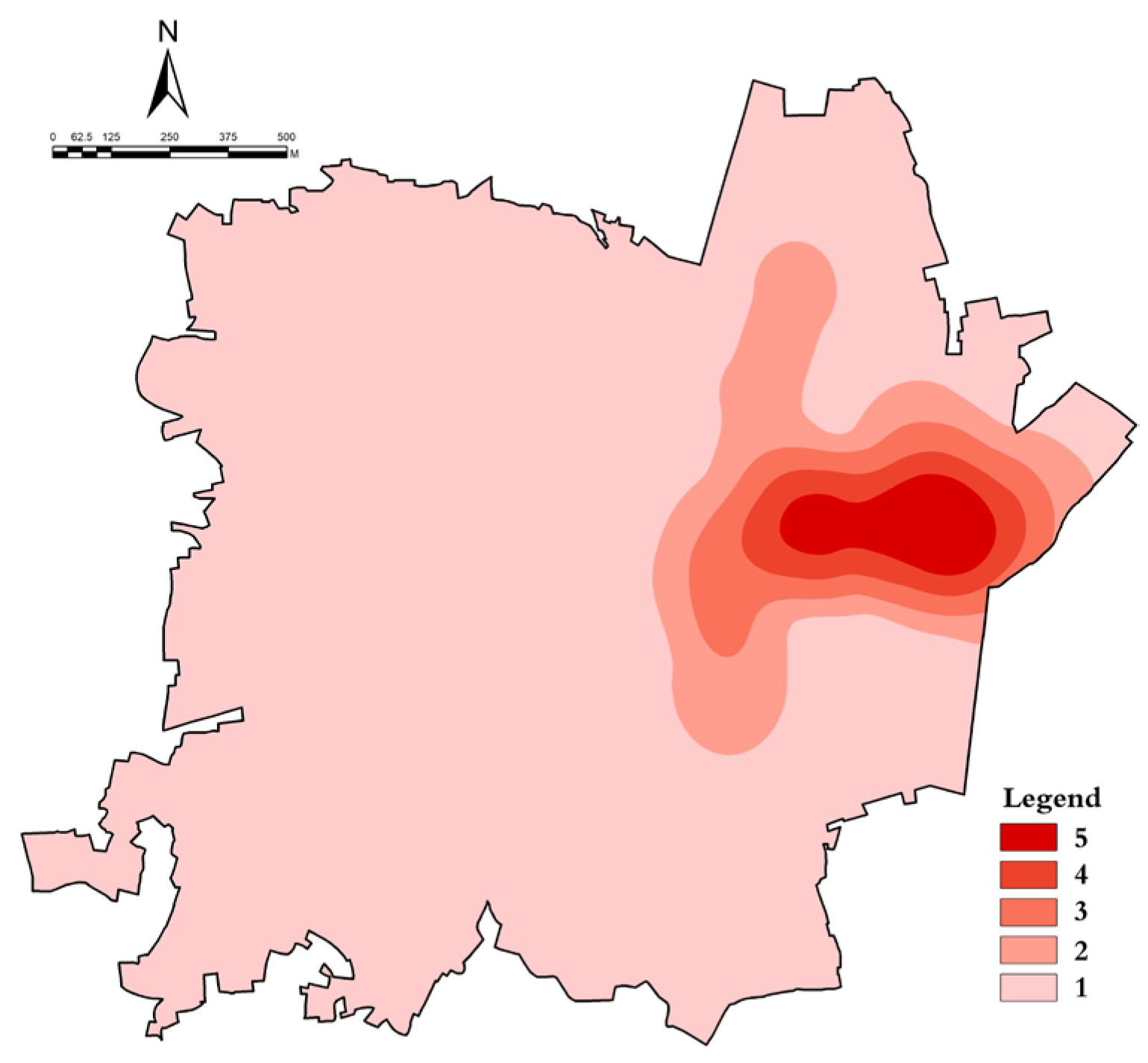

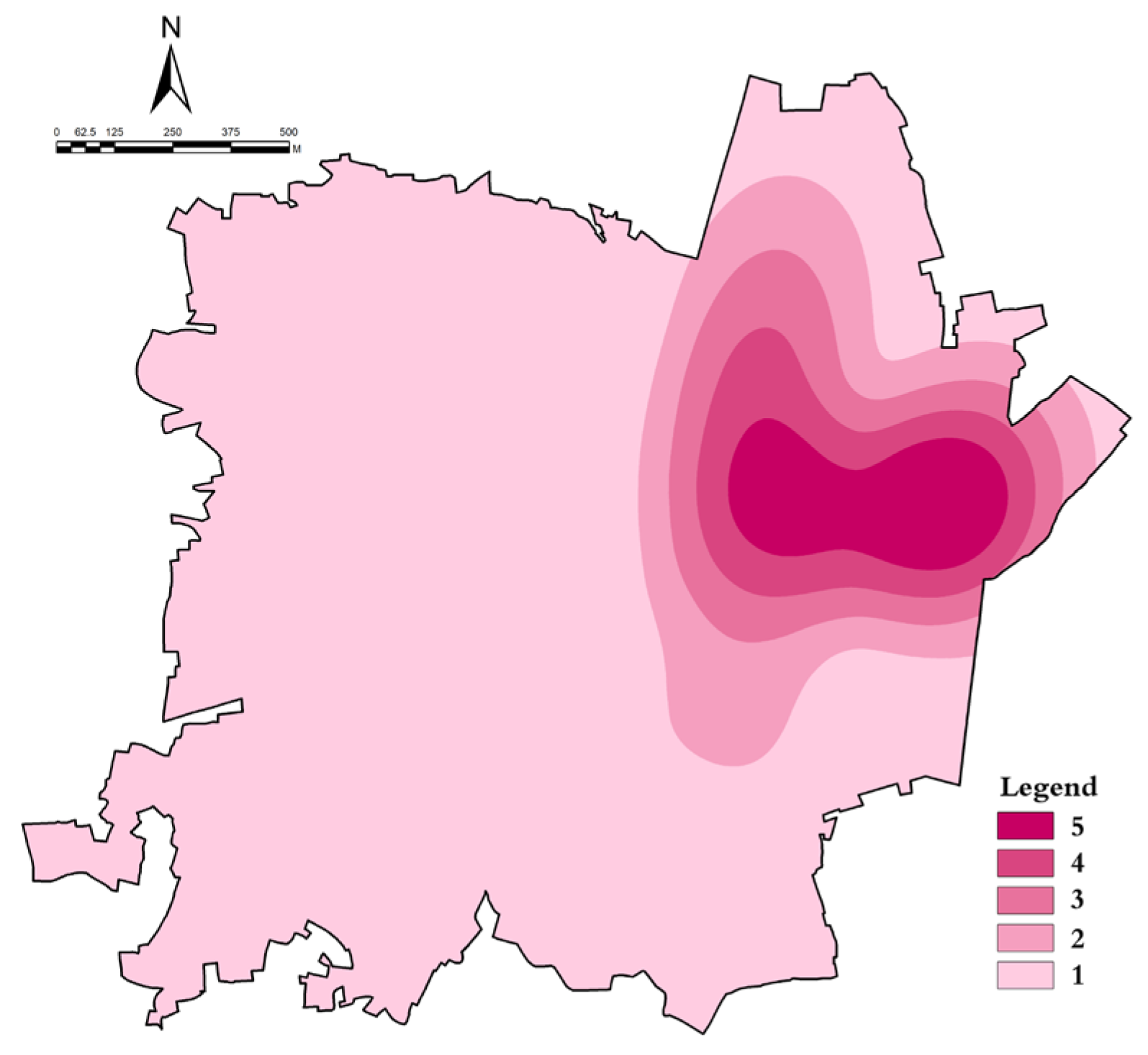

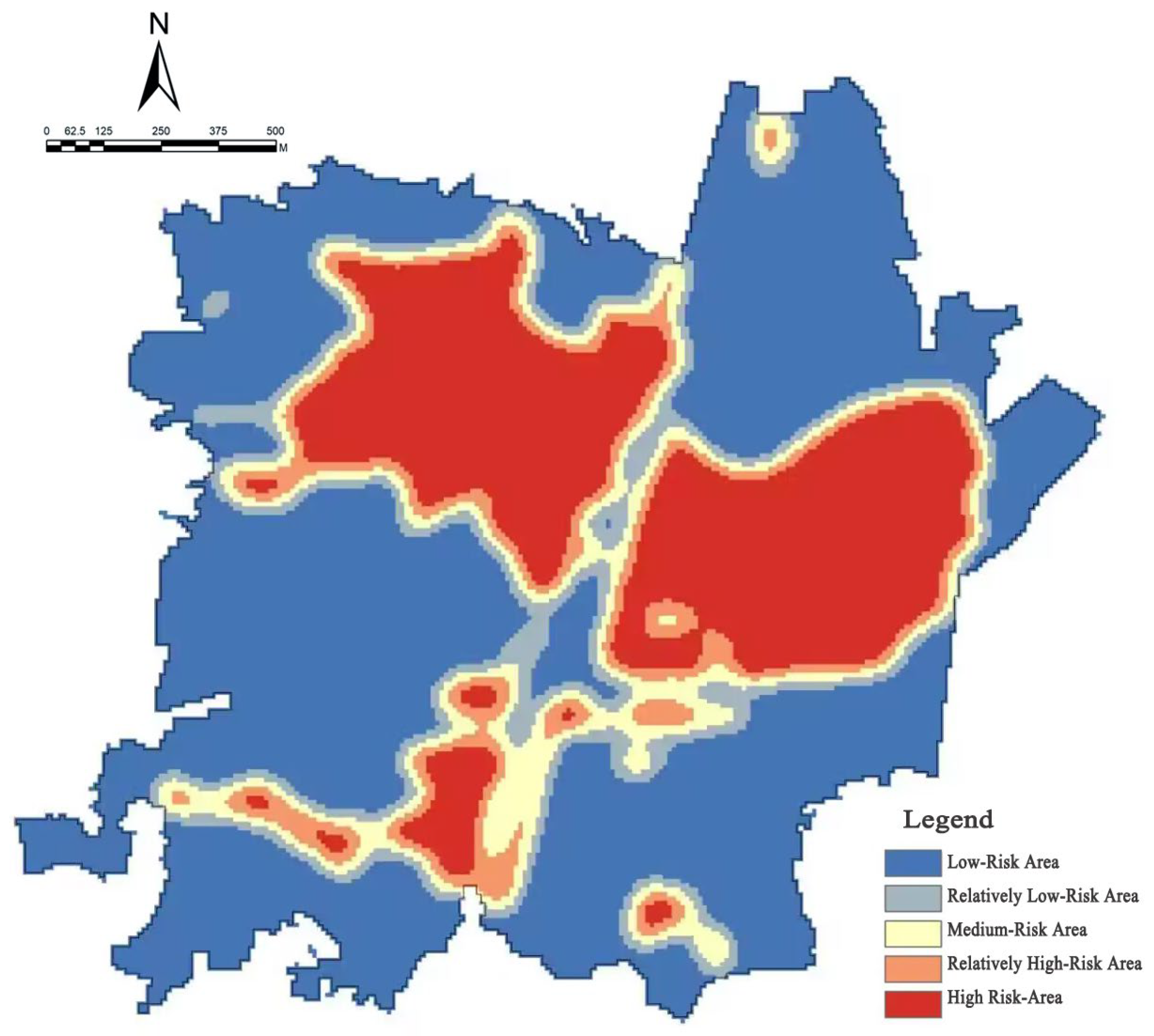
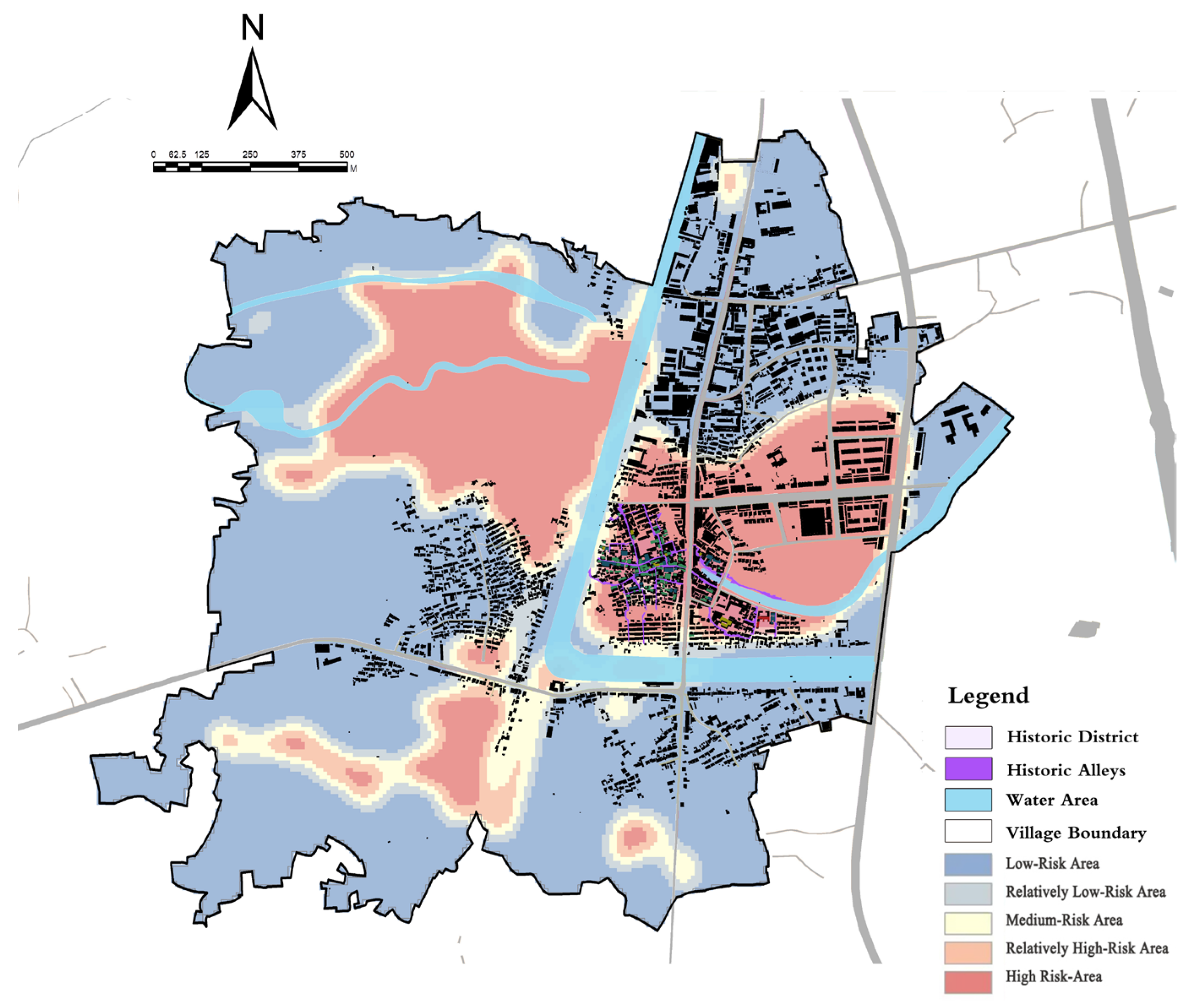
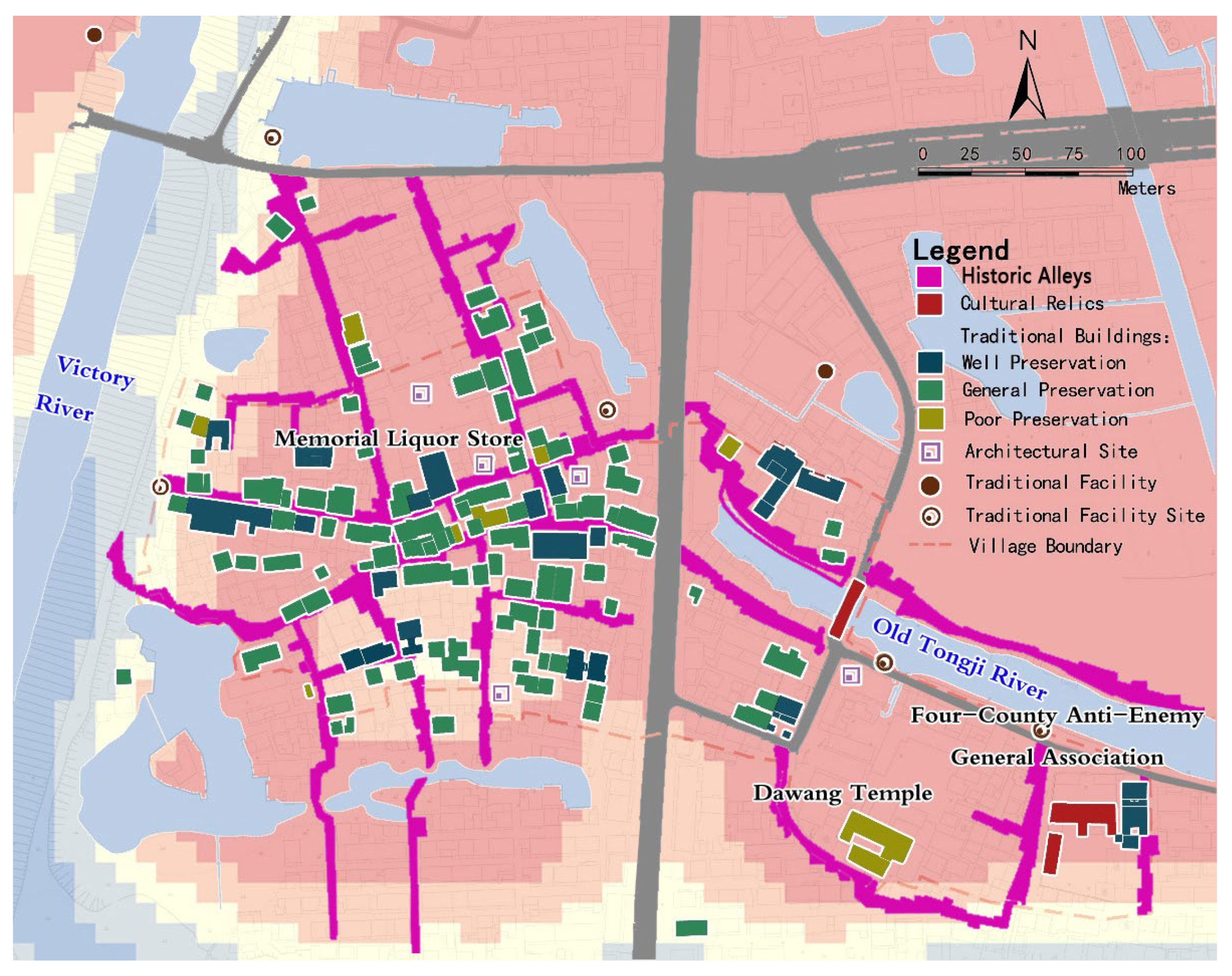

| Aim | Primary Indicator | Code | Secondary Indicator | Weight |
|---|---|---|---|---|
| Calculation of Historical Hydrological Resilience index (HHRI) | Ecological Governance Resilience | X1 | Historical Terrain Change | 0.05 |
| X2 | Ecological Vegetation Coverage | 0.05 | ||
| X3 | Natural River Channel Stability | 0.10 | ||
| X4 | Weir Field Integrity | 0.10 | ||
| X5 | Effectiveness of Water Conservancy Facilities | 0.10 | ||
| Cultural Heritage Resilience | X6 | Historical Pattern Integrity | 0.07 | |
| X7 | Coordination Degree of Historical Features | 0.07 | ||
| X8 | Protection Rate of Traditional Buildings | 0.06 | ||
| Social Adaptation Resilience | X9 | Disturbance of Crowd Activities | 0.10 | |
| X10 | Community Disaster Resistance Organization Ability | 0.05 | ||
| X11 | Historical Industry Adaptability | 0.05 | ||
| X12 | Transmission Degree of Traditional Disaster Bearing Knowledge | 0.10 |
| Primary Indicator | Code | Secondary Indicator | Data Source |
|---|---|---|---|
| Ecological Governance Resilience (0.42) | X1 | Historical Terrain Change | Historical records, DEM |
| X2 | Ecological Vegetation Coverage | NDVI | |
| X3 | Natural River Channel Stability | Historical water system map, remote sensing data | |
| X4 | Weir Field Integrity | Field research, land use data | |
| X5 | Effectiveness of Water Conservancy Facilities | Engineering archives, on-site inspection | |
| Cultural Heritage Resilience (0.23) | X6 | Historical Pattern Integrity | Field research, land use data |
| X7 | Coordination Degree of Historical Features | Field research, land use data | |
| X8 | Protection Rate of Traditional Buildings | Field research, land use data | |
| Social Adaptation Resilience (0.35) | X9 | Disturbance of Crowd Activities | Mobile phone signaling data |
| X10 | Community Disaster Resistance Organization Ability | Interview records, questionnaire surveys | |
| X11 | Historical Industry Adaptability | Economic statistics, industry research | |
| X12 | Transmission Degree of Traditional Disaster Bearing Knowledge | Intangible cultural heritage survey, oral history |
| First- Level Indicator | Ecological Governance Resilience | Cultural Heritage Resilience | Social Adaptation Resilience | |||||||||
|---|---|---|---|---|---|---|---|---|---|---|---|---|
| Code | X1 | X2 | X3 | X4 | X5 | X6 | X7 | X8 | X9 | X10 | X11 | X12 |
| Historical Scenarios | 1.00 | 1.00 | 1.00 | 1.00 | 1.00 | 1.00 | 1.00 | 1.00 | 1.00 | 1.00 | 1.00 | 1.00 |
| 1.00 | 1.00 | 1.00 | ||||||||||
| Current Situation | 0.91 | 0.42 | 0.40 | 0.02 | 0.54 | 0.64 | 0.35 | 0.39 | 1.67 | 1.98 | 0.26 | 0.28 |
| 0.48 | 0.46 | 1.05 | ||||||||||
| Code | X1 | X2 | X3 | X4 | X5 | X6 | X7 | X8 | X9 | X10 | X11 | X12 |
|---|---|---|---|---|---|---|---|---|---|---|---|---|
| Obstacle Indicators | 0.01 | 0.09 | 0.18 | 0.29 | 0.14 | 0.08 | 0.13 | 0.11 | −0.20 | −0.14 | 0.11 | 0.21 |
| Levels of Cultural Value | Heritage Typology | Resources | Amount |
|---|---|---|---|
| First Level | Immovable Cultural Relics | Site of the Four County Anti-Enemy Conference, Taiping Bridge, the Shi Family Residence | 3 |
| Second Level | Historical Buildings | Yi He Wine Celler, Old Magistrate’s Court, Renhe Soya Sauce Workshop, Iron pot shop, the Huang Family Cloth Shop, Wang Shun Xing Restaurant, Wang Rui Ji Cloth Shop, Ming Ji Wine Celler, Yi He Paper Shop, The Yang Family Residence, The Residence in the Middle Camp, Ming Yue Xuan Teahouse, Residence around Taiping Bridge, Bank of the Old Times, Post office in the Republic of China, Zhang Jia Salt Station. | 16 |
| Third Level | Traditional Buildings | Great Temple, Old Barber shop, Site of Wang Gong Sheng Ancestral Hall, Site of Bian Family Ancestral Hall | 12 |
| Traditional Facilities (Sites) | Huang Guan River Floodgate, Little River Floodgate Site, Xiao Ping Bridge Site, Grand Dock Site, Salt Dock Site, Wine Dock Site, Wood Dock Site, Chimney |
| Key Obstacle Factors | Nature-Based Solutions (Nbs) | Hard Engineering Techniques | Soft Institutions and Community Engagement | Cultural Activation and Intellectual Inheritance |
|---|---|---|---|---|
| X3: Stability of natural waterways | Restore the riverbank buffer zone and plant aquatic plants (reeds, calamus) to stabilize the slope and purify water | Ecological slope protection, embedded sensor monitoring | Establish village regulations for river management and protection | Integrate traditional river management wisdom, such as “planting willows to build embankments”, into modern ecological engineering |
| X4: Weir field integrity | Build a terraced landscape belt to exert its ecological function of rain and flood detention | — | Implement the “Weir Field Adoption” program to create a social innovation of distributed maintenance | Use the weir field system as an experience site for ecological agriculture and nature education to revitalize traditional agricultural wisdom |
| X12: Inheritance of traditional disaster tolerance knowledge | — | — | Establish a “water lane manager” system and conduct participatory planning workshops | Use AR technology to create immersive educational experiences in water heritage and promote the intergenerational transmission of knowledge |
Disclaimer/Publisher’s Note: The statements, opinions and data contained in all publications are solely those of the individual author(s) and contributor(s) and not of MDPI and/or the editor(s). MDPI and/or the editor(s) disclaim responsibility for any injury to people or property resulting from any ideas, methods, instructions or products referred to in the content. |
© 2025 by the authors. Licensee MDPI, Basel, Switzerland. This article is an open access article distributed under the terms and conditions of the Creative Commons Attribution (CC BY) license (https://creativecommons.org/licenses/by/4.0/).
Share and Cite
Wang, H.; Liu, P.; Shan, Y.; Zhang, J.; Xia, S. Evolutionary Characteristics, Improvement Strategies and Driving Mechanisms of the Human Settlement Environment in Chinese Traditional Villages Based on Historical Hydrological Resilience Assessment. Buildings 2025, 15, 4264. https://doi.org/10.3390/buildings15234264
Wang H, Liu P, Shan Y, Zhang J, Xia S. Evolutionary Characteristics, Improvement Strategies and Driving Mechanisms of the Human Settlement Environment in Chinese Traditional Villages Based on Historical Hydrological Resilience Assessment. Buildings. 2025; 15(23):4264. https://doi.org/10.3390/buildings15234264
Chicago/Turabian StyleWang, Haobing, Pengcheng Liu, Yong Shan, Junxue Zhang, and Sisi Xia. 2025. "Evolutionary Characteristics, Improvement Strategies and Driving Mechanisms of the Human Settlement Environment in Chinese Traditional Villages Based on Historical Hydrological Resilience Assessment" Buildings 15, no. 23: 4264. https://doi.org/10.3390/buildings15234264
APA StyleWang, H., Liu, P., Shan, Y., Zhang, J., & Xia, S. (2025). Evolutionary Characteristics, Improvement Strategies and Driving Mechanisms of the Human Settlement Environment in Chinese Traditional Villages Based on Historical Hydrological Resilience Assessment. Buildings, 15(23), 4264. https://doi.org/10.3390/buildings15234264






